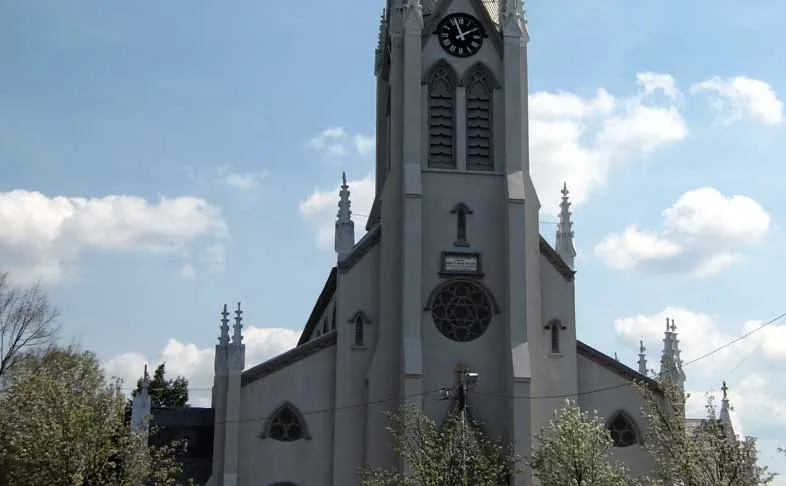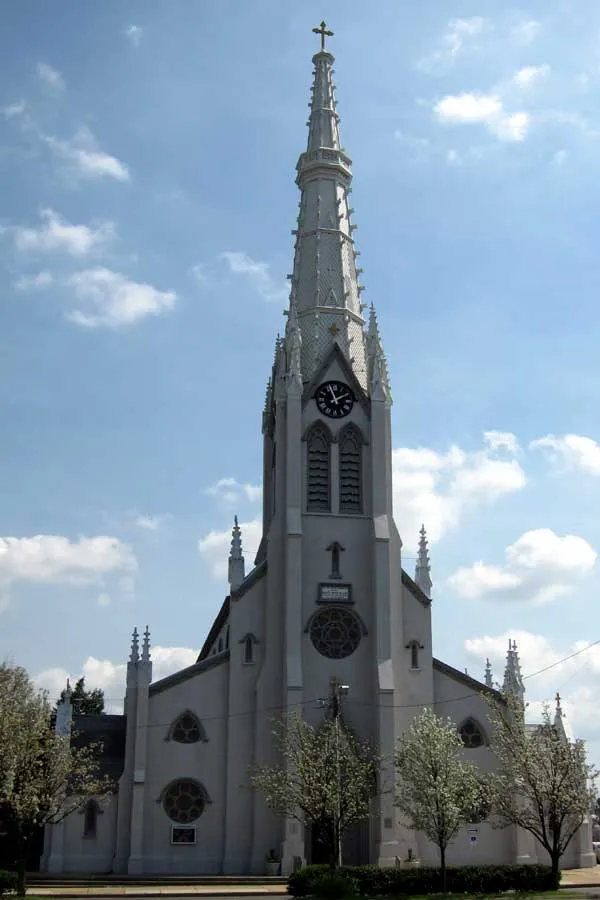
Introduction
The Basilica of St. Mary of the Immaculate Conception is located in downtown Norfolk. It is the oldest parish community in the Catholic Diocese of Richmond and often referred to as “The Mother Church of Tidewater Virginia.” It came into existence in 1791 as St. Patrick’s Church which was two years before the establishment of the United States hierarchy and twenty-nine years before the institution of the Richmond Diocese. Its first parishioners were French Catholics, compelled to abandon their native land by the French Revolution. In a matter of years, it received some of the earliest Irish Catholic immigrants to the United States.
The white spire of the church bursts forth from the south end of the St. Paul’s neighbourhood. Flanked by public housing, the building is from an era when steeples dominated the Norfolk skyline rather than towering office buildings and hotels. That white spire is flanked by smaller Gothic spires lining both sides of the roof, making the Catholic church stand out among the area’s many Protestant houses of worship.
Step inside the huge red doors today, out of the cold and away from the sound of cars zooming down the highway off-ramp a hundred or so feet away, and you’ll find yourself in a cavernous, awe-inspiring architectural feat that evokes the biblical dome of the heavens.
But for years, those Gothic spires outside have been surrounded with scaffolding. And big swaths of that glorious vaulted ceiling were being removed and replaced.
What was supposed to be a quick fix snowballed to epic proportions. Issue after issue led work crews to spend the better part of the past four years repairing St. Mary’s. Much of the church’s roof and upper structure has effectively been rebuilt, while the interior was almost completely gutted and revamped.
Luther Adams Jr. is the church’s sextant, the minder of the building and the first one to open things up each morning. He’s been attending St. Mary’s for more than 30 years and knows the building inside and out. It’s a building with a lot of history.
St. Mary’s is one of only two basilicas in Virginia – significant Catholic churches specially designated by the pope himself – and the only African-American one in the United States. It was the state’s only basilica until another St. Mary’s (in Alexandria) was named one a few years ago.

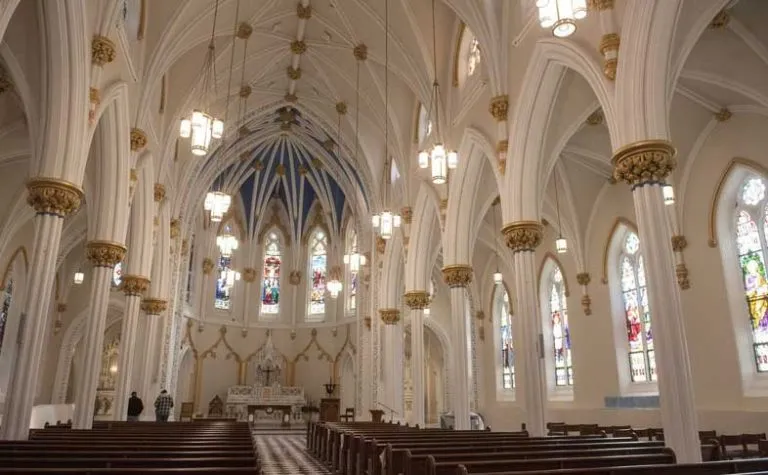
History of Saint Mary of the Immaculate Conception
The parish began in 1791 as Saint Patrick Church founded by French Catholics fleeing the French Revolution who were joined by some of the earliest Irish Catholic immigrants to the United States. St. Patrick’s was the oldest parish in the Richmond Diocese and predated the formation of the diocese by 29 years.
First building – The first church edifice was built in 1842.
Since it was in the Southern United States, the racially segregated Christian church was for Whites only. Fr. Matthew O’Keefe initiated permitting African American Catholics to sit in an assigned portion of the choir loft for their use only. The anti-Catholic Know Nothings threatened him unless the church instituted segregated Masses, which he refused. Thugs tried to intimidate White parishioners until Fr. O’Keefe obtained police protection.
The church was destroyed by fire in 1856. Diocesan records show that local Catholic families believed the Know Nothings were responsible. “The Assumption,” a painting donated by King Louis Philippe and Queen Amelie, was lost in the blaze.
Rebuilding – The present building was completed in 1858 and was rededicated under the title of the Blessed Virgin Mary of the Immaculate Conception in commemoration of the Marian dogma proclaimed in 1854 by Pope Pius IX.
The parish supported St. Mary Academy, an inner-city school that provided a Christian education to hundreds of urban children, most of whom were non-Catholic; however, circumstances eventually forced the academy to close. The parish also operates a soup kitchen and provides other outreach to Norfolk’s poor and homeless.

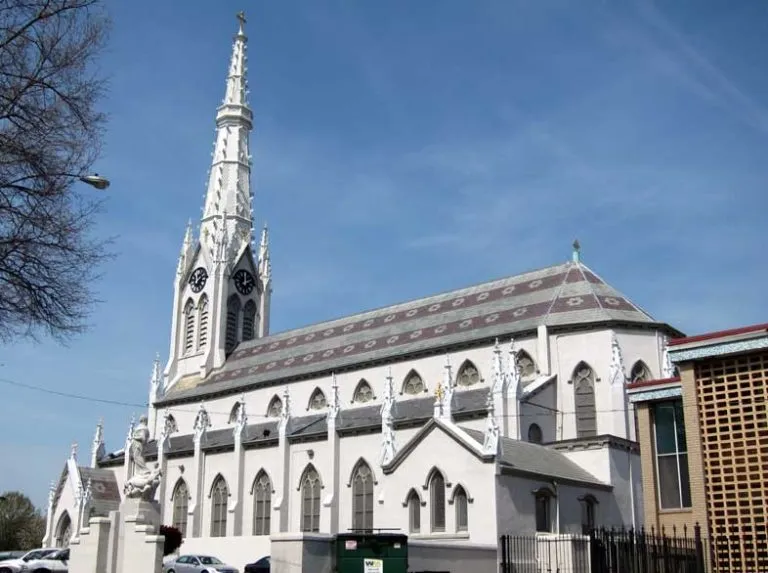
Merger and Renovation
In 1961, seventy-two years after its founding, Saint Joseph’s – a nearby Black Catholic parish staffed by the Josephites – was clustered with Saint Mary’s. The newly combined parish would later boast 99% African American membership.
After being added to the National Register of Historic Places in 1979 and undergoing an extensive renovation and restoration program, the edifice was rededicated on November 1, 1989.

Minor Basilica
On the occasion of the 200th anniversary of the church, December 8, 1991, Pope John Paul II proclaimed the Church of Saint Mary of the Immaculate Conception a minor basilica, the only one in the Commonwealth of Virginia and the only one with African-American predominance: The official proclamation was read by Apostolic Pro-Nuncio, Archbishop Agostino Ciacciavillan who also served as the principal celebrant of the Liturgy. Being named a minor basilica is an honor given by the Pope. It becomes a place of pilgrimage and is an honorary title recognizing the distinguished nature of St. Mary. There are 33 other minor basilicas in the United States, St Mary is the only one in the Commonwealth of Virginia.
“Your Black cultural heritage enriches the Church and makes her witness of universality more complete. In a real way the Church needs you, just as you need the Church, for you are a part of the Church and the church is part of you.”
Despite the renovations in 1979, a litany of structural issues developed, with a 2015 inspection revealing massive rot and termite damage in the walls and roof. This kick started a second restoration project, to the tune of some $6.7M, which was completed in December 2020.
During the project, discovery was made of a series of crypts and tunnels under the church floor, the latter of which are speculated to have been involved with the Underground Railroad. The restoration also brought back into use the church’s historic organ, which had laid dormant since 1981.

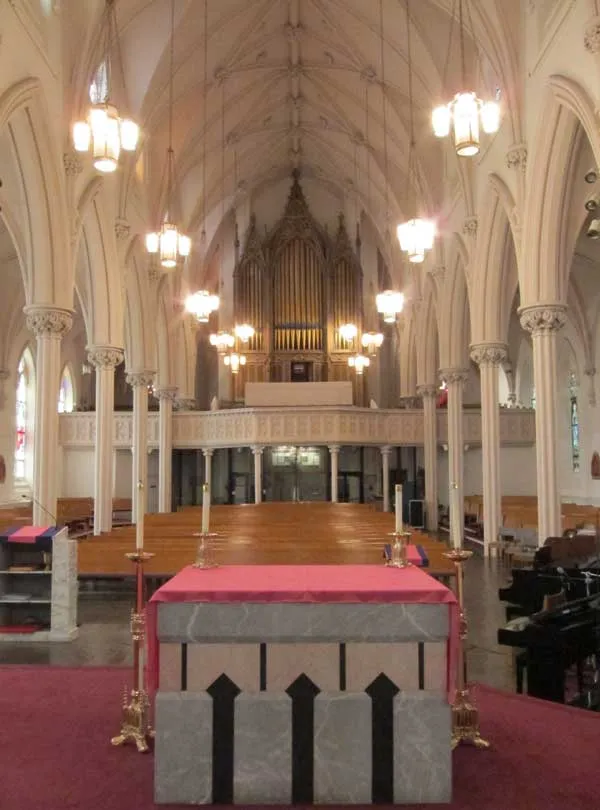
Architecture
Architectural style: Gothic Revival architecture.
When Fr. Matthew O’Keefe moved north to Maryland, he modeled his new church after St. Mary’s. Completed in 1906, Church of the Immaculate Conception in Towson shares the blueprints of St. Mary’s with the exceptions of a larger rose window rather than a spire, thicker interior columns, and brownstone accents to the buttress and windows. Father O’Keefe, the first pastor of the new St. Mary’s (Norfolk) and Immaculate Conception (Towson), is buried beneath the altar of the latter.
The restored space, all white and gold vaulting ceilings and sparkling stained glass, enthralls its parishioners.
While standing in the nearly-finished nave, looking around as the sun streamed through the stained glass and dyed the checkerboard floor around us in different shades of red and yellow and blue.
Irene Elliot came to St. Mary’s in the late 1950′s, when the nearby St. Joseph’s was set to be torn down and the congregations of the churches were merged – leading St. Mary’s to become the largely Black flock it is today.

Feast Day – 8th December
Annual Feast Day of the Immaculate Conception of the Blessed Virgin Mary will be held on 8th December.
Holy Days of Obligation
Mass Time
Tuesdays & Fridays
Saturdays
Sundays
Church Visiting Time
Contact Info
232 Chapel Street, Norfolk,
VA 23504, United States
Phone No.
Tel : +1 757-622-4487
Accommodations
How to reach the Basilica
Norfolk International Airport is the nearby Airport to the Basilica.
Monticello, MacArthur Square Station, Civic Plaza Station are the nearby Train Stations to the Basilica.

